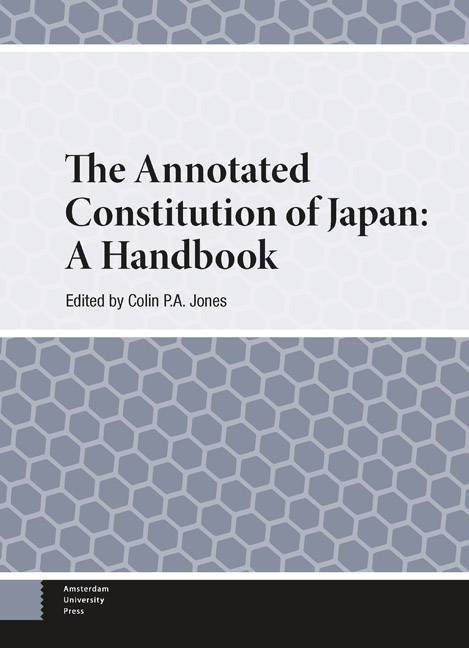Book contents
- Frontmatter
- Dedication
- Contents
- Contributors
- Preface
- Acknowledgements
- Introduction: Historical Overview
- The Preamble
- 1 Chapter I: The Emperor (Articles 1–8)
- 2 Chapter II: Renunciation of War (Article 9)
- 3 Chapter III: Rights and Duties of the People (Articles 10–40)
- 4 Chapter IV: The Diet (Articles 41–64)
- 5 Chapter V: The Cabinet (Articles 65–75)
- 6 Chapter VI: The Judiciary (Articles 76–82)
- 7 Chapter VII: Finance (Articles 83–91)
- 8 Chapter VIII: Local Self Government (Articles 92–95)
- 9 Chapter IX: Amendments (Article 96)
- 10 Chapter X: Supreme Law (Articles 97–99)
- 11 Chapter XI: Supplementary Provisions (Articles 100–103)
- Appendix 1 Constitution of the Empire of Japan (Japanese)
- Appendix 2 Constitution of the Empire of Japan (English translation)
- Appendix 3 The Potsdam Declaration
- Appendix 4 Instrument of Surrender
- Appendix 5 The “MacArthur Notes”
- Appendix 6 The GHQ Draft
- Appendix 7 The Constitution of Japan (Japanese)
- Appendix 8 The Treaty of San Francisco
- Bibliography
- Index
- Index of Articles of the Constitution of Japan
9 - Chapter IX: Amendments (Article 96)
Published online by Cambridge University Press: 13 February 2024
- Frontmatter
- Dedication
- Contents
- Contributors
- Preface
- Acknowledgements
- Introduction: Historical Overview
- The Preamble
- 1 Chapter I: The Emperor (Articles 1–8)
- 2 Chapter II: Renunciation of War (Article 9)
- 3 Chapter III: Rights and Duties of the People (Articles 10–40)
- 4 Chapter IV: The Diet (Articles 41–64)
- 5 Chapter V: The Cabinet (Articles 65–75)
- 6 Chapter VI: The Judiciary (Articles 76–82)
- 7 Chapter VII: Finance (Articles 83–91)
- 8 Chapter VIII: Local Self Government (Articles 92–95)
- 9 Chapter IX: Amendments (Article 96)
- 10 Chapter X: Supreme Law (Articles 97–99)
- 11 Chapter XI: Supplementary Provisions (Articles 100–103)
- Appendix 1 Constitution of the Empire of Japan (Japanese)
- Appendix 2 Constitution of the Empire of Japan (English translation)
- Appendix 3 The Potsdam Declaration
- Appendix 4 Instrument of Surrender
- Appendix 5 The “MacArthur Notes”
- Appendix 6 The GHQ Draft
- Appendix 7 The Constitution of Japan (Japanese)
- Appendix 8 The Treaty of San Francisco
- Bibliography
- Index
- Index of Articles of the Constitution of Japan
Summary
Article 96.
(1) Amendments to this Constitution shall be initiated by the Diet, through a concurring vote of two-thirds or more of all the members of each House and shall thereupon be submitted to the people for ratification, which shall require the affirmative vote of a majority of all votes cast thereon, at a special referendum or at such election as the Diet shall specify.
(2) Amendments when so ratified shall immediately be promulgated by the Emperor in the name of the people, as an integral part of this Constitution.
Historical background
The Constitution of Japan has never been amended since its birth, as an amendment in toto of the Meiji Constitution, which itself had never been amended until then. Article 73 of the Meiji Constitution required proposed amendments to be submitted by Imperial Order, but proposed amendments could not be debated by either House unless a quorum comprising at least two-thirds of its membership was present, and a two-thirds supermajority requirement was required to approve it. The two-thirds threshold for amendment under Article 96 appear to have been inherited from the Meiji Constitution.
The GHQ drafting team initially considered imposing heavy restrictions on the people's right of amendment—their initial internal draft would have prohibited any until 1955 and only allowed them thereafter if proposed by a 2/3 vote of the Diet and subsequently ratified by not less than a 3/4 vote of the Diet. A subsequent internal draft required a 3/4 vote of both Diet chambers and a popular referendum. The provision that was ultimately proposed in the GHQ Draft (Article LXXXIX) became Article 96, subject to a few minor changes relating to bicameralism and permitting “a special referendum” for ratification.
Although at the time of writing the present constitution has never been amended, various proposals have been in the Diet and elsewhere, but none have come even close to going anywhere. Well-known examples include:
• A comprehensive set of amendments proposed by the LDP in 2012
• Amendments proposed by the Sankei and Yomiuri newspapers in 2013 and 2014, respectively
• A 2012 proposal by Prime Minister Abe to first “just” amend Article 96 to make the amendment process easier
• A 2017 proposal by Abe to amend Article 9 to add language acknowledging the existence of the SDF
- Type
- Chapter
- Information
- The Annotated Constitution of JapanA Handbook, pp. 307 - 311Publisher: Amsterdam University PressPrint publication year: 2023



